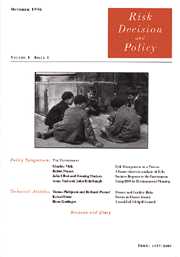Article contents
Hierarchical influence diagrams for incorporating human and organizational factors in risk assessment of hazardous industrial systems
Published online by Cambridge University Press: 22 May 2002
Abstract
The paper addresses basic issues associated with incorporating human and organizational factors in risk analysis of hazardous systems. A conceptual framework has been developed for systematic incorporating these factors in probabilistic models and the risk assessment to be used for the safety management. The methodology outlined in the paper is a synthesis or generalization of techniques and procedures used for performing HRA in the context of PSA, applying both the quantitative and qualitative methods. The similarities and differences of hierarchical influence diagrams (HIDs) compared with hierarchical structures of the AHP method and the influence diagrams used in the FSA methodology developed by IMO are examined. Illustrative examples are included. Finally a fuzzy extension of the proposed approach is introduced.
- Type
- Technical Article
- Information
- Copyright
- © Risk Decision and Policy, 2002
- 2
- Cited by


